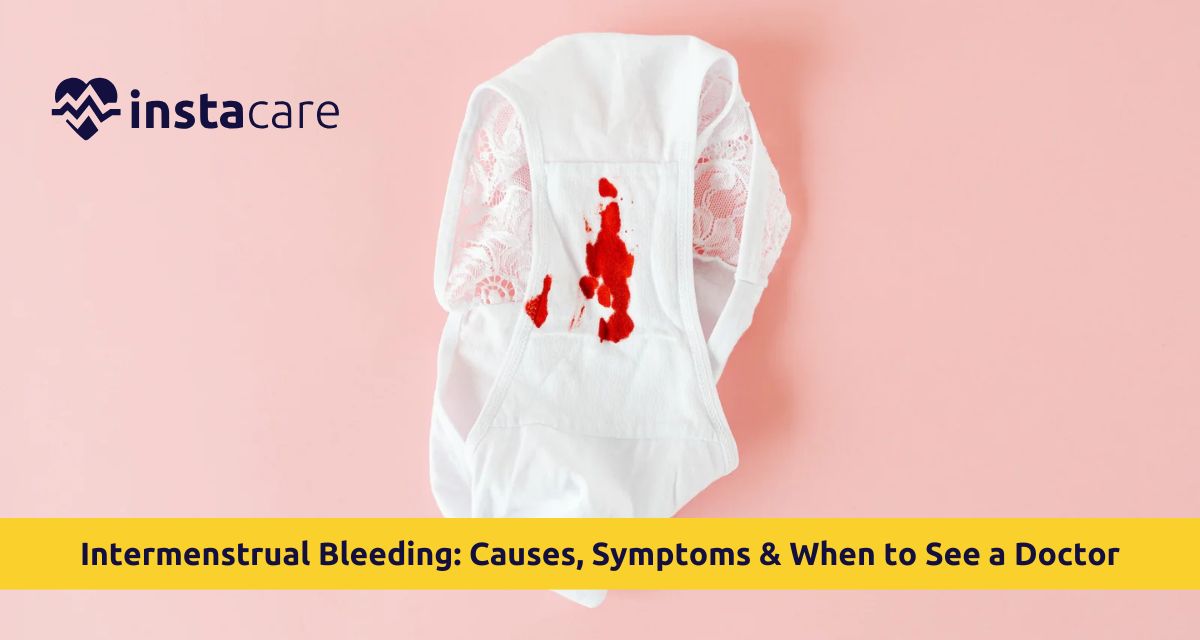Intermenstrual bleeding or mid-cycle bleeding scares the majority of women. Although periodic spotting during menstruation is never because of anything, frequent or heavy bleeding can be a reflection of some medical disorders that will be treated by a doctor. This educational piece describes why intermenstrual bleeding happens, what are its most prevalent symptoms, its risk factors, and when to visit the doctor.
What Is Intermenstrual Bleeding?
Intermenstrual bleeding is bleeding within the vagina between normal menstrual periods. Intermenstrual bleeding can range from slight spotting between periods to heavier menstrual flows that are the same as a menstrual period.
As prevalent as this will appear, intermenstrual bleeding will usually be caused by a variety of reasons, some less than completely evil but less than completely angelic either. The better you know the causes of intermenstrual bleeding, the better you'll know when to hold on and when to summon the experts.
Causes of Intermenstrual Bleeding
The etiologies of intermenstrual bleeding are varied, from hormonal imbalance to anatomical defects of the reproductive organs. These are the most common causes listed below.
Hormonal Imbalance Bleeding
Your period is normally controlled by hormones. Alteration in any case-stress, illness, or some medication-can lead to hormonal imbalance and hence cause bleeding. Abnormal ovulation, thyroid illness, or
menopause can be disruptive to hormones and hence lead to spotting.
Ovulation Bleeding (Mid-Cycle Bleeding)
Others experience mid-cycle bleeding when the egg typically day 14 of a 28-day cycle is expelled from the ovary. Ovulation bleeding will be light spotting and, in some cases, can be followed by cramps.
Breakthrough Bleeding on Birth Control
Breakthrough bleeding occasionally may be caused by hormonal contraceptives. This should be with the first few weeks of treatment with a new contraceptive, or with missed pills.
Implantation Bleeding and Intermenstrual Bleeding
Implantation bleeding results from the implantation of the fertilized egg onto the uterine lining. It occurs most frequently 6-12 days after insemination. Implantation bleeding vs intermenstrual bleeding are different. Being mistaken for intermenstrual bleeding, implantation bleeding is lighter and less frequent.
Fibroids and Uterine Bleeding
Fibroids are benign growths or tumors in the uterus, which may cause intermenstrual bleeding and menorrhagia. Fibroids vary in size and location and may even cause pelvic pressure, pain, and prolonged menstruation.
Polycystic Ovary Syndrome Bleeding
PCOS women will have irregular menstrual cycles because of endocrine imbalance. Polycystic ovary syndrome (PCOS) bleeding may be between cycles due to unregular ovulation or hyperplastic endometrial lining.
Endometrial Polyps
Endometrial polyps are tumors of the uterine lining and one of the most common reasons for intermenstrual bleeding. They may cause irregular menstrual Bleeding between periods, heavy periods, or postcoital spotting.
Cervical Bleeding
Cervical abnormalities, cervical polyps, infection, or inflammation, may cause cervical bleeding. Postcoital bleeding sometimes is the primary presentation of a cervical abnormality.
Postcoital Bleeding
Postcoital bleeding can be caused by cervical infections, trauma, polyps, or even its first appearances in cervical cancer. Spotting during intercourse can be a real annoyance, but must be evaluated if it is recurring on a regular basis.
Intermenstrual Bleeding and Cancer Risk
Though not the most frequent etiology, atypical intermenstrual bleeding might appear as a manifestation of cervical, endometrial, or uterine neoplasm. Postmenopausal bleeding and cancer threat are synonymous or in the context of an abnormal Pap smear.
Diagnostic Workup of Abnormal Uterine Bleeding
Establishing the etiology of abnormal uterine bleeding is necessitated by extensive medical workup. Diagnostic workup may involve:
- Medical History and Review of Symptoms: The doctor will ask about the frequency of bleeding between menstruations, its duration and quantity. He or she will inquire regarding use of medications, history of oral contraceptives, and history of menstruation.
- Pelvic Examination: The pelvic examination can detect cervical polyps, infection, or other disease processes that cause bleeding from the cervix or coital bleeding.
- Pap Smear and HPV Test: These are cervical cancer and human papillomavirus infection causing abnormal bleeding tests.
- Ultrasound Exam: Transvaginal ultrasound can diagnose Uterine fibroids and bleeding, endometrial polyps, or ovarian cysts, which are extremely informative about the state of the uterus and ovaries.
- Endometrial Biopsy: If cancer is suspected, i.e., in a woman over 40, or with intermenstrual bleeding and cancer risk, endometrial biopsy can be performed to biopsy uterine lining tissue.
- Hormonal Testing: By measuring blood levels of hormones which can diagnose hormonal imbalance bleeding or such conditions, e.g., PCOS.
Symptoms Associated with Intermenstrual Bleeding
Aside from the apparently self-explanatory spot-tuning between menstruations, other symptoms can reveal the cause:
- Dyspareunia (painful intercourse)
- Pressure or pain in the pelvis
- Lower abdominal cramping
- Heavier periods than usual for you
- Irregular periods
- Bleeding after sex
- Fatigue due to blood loss
You should pay attention to these symptoms as they are likely to account for conditions such as fibroids or PCOS, endometrial polyps etc.
When to See a Doctor
Although occasional spotting is normal, there are many different situations that need instant medical attention
- Long intermenstrual bleeding that persists over multiple cycles
- Severe or painful intermenstrual bleeding
- Cyclic postcoital bleeding
- Painful or heavy intermenstrual bleeding
- Abnormal discharge, pelvic pain or exhaustion with associated bleeding
- Positive history for abnormal Pap test or cervical cancer risk factors
Unmanaged abnormal bleeding will result in postponement of the diagnosis of such life-threatening health conditions as cancer. Always report your physician if you experience abnormal or recurrent bleeding.
How Is Intermenstrual Bleeding Treated
Treatment depends on the etiology of intermenstrual bleeding and may consist of:
Hormonal Treatments
Hormonal IUD or oral contraceptive pills, menstrual cycle regulation, and prevention of imbalance hormonal bleed.
Hormone therapy can be given to women who are approaching menopause.
Surgical Removal of Polyps or Fibroids
If polyps or fibroids of endometrium or uterus are the cause of recurrent bleeding or pain, these can be excised surgically.
PCOS Management
- Hormonal therapy
- Weight management, and life-style modification
Treatment of PCOS bleeding and restoration of normal ovulation.
Infection Management
Antibiotics or antiviral therapy for cervical infection or sexually transmitted infection causing cervical bleeding.
Management of Cancer
Treatment of cancer bleeding is treated by surgery, radiation, chemotherapy, or combined modality depending on the cancer type and size.
Prevention of Intermenstrual Bleeding
Even prevention of every case cannot be guaranteed, but development of healthy lifestyle can minimize your risk:
- Adhere to hormonal contraception as advised
- Follow healthy weight and PCOS management
- Keep visiting your gynecologist regularly and having Pap smears
- Treat early infection
- Practice safe sex to avoid cervix infection
- Observe menstrual cycle transition and call your gynecologist's attention to any deviation
Conclusion
Intermenstrual bleeding is not to be underestimated. Although in certain situations it may be harmless, like bleeding during ovulation or implantation bleeding, it can be a sign of some underlying pathology such as uterine fibromyomas, PCOS, or malignancy if heavy and recurring.
Your reproductive well-being is contingent on the understanding of the potential etiologies of intermenstrual bleeding, the way in which the associated symptoms are identified, and early clinical assessment. Should you observe spotting between cycles, do not hesitate, consult your gynecologist for proper diagnosis of abnormal uterine bleeding and reassurance.
Please book an appointment with the
best Gynecologist in Lahore, Karachi, Islamabad, and all major cities of Pakistan through
InstaCare, or call our helpline at 03171777509 to find a verified doctor for your disease.

